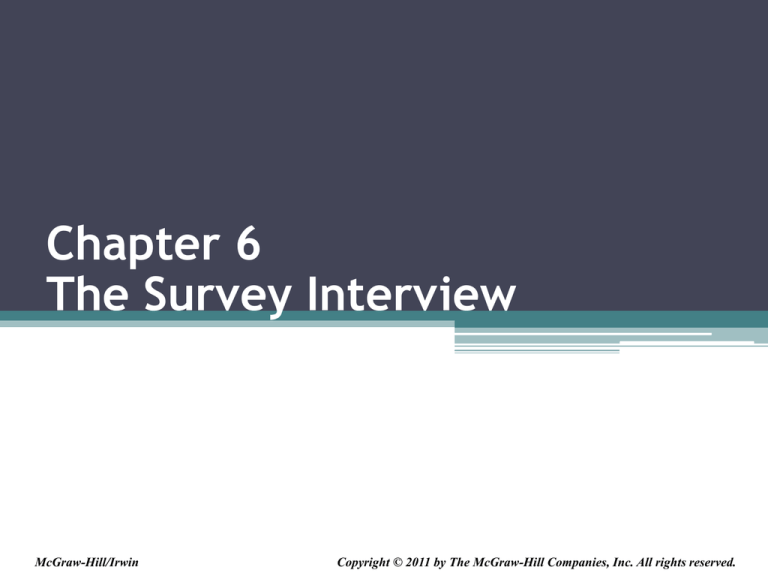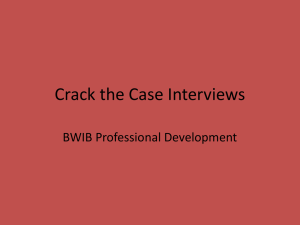
Chapter 6
The Survey Interview
McGraw-Hill/Irwin
Copyright © 2011 by The McGraw-Hill Companies, Inc. All rights reserved.
6-2
Chapter Summary
•
•
•
•
•
•
•
•
•
Purpose and Research
Structuring the Interview
Survey Questions
Selecting Interviewees
Selecting and Training Interviewers
Conducting Survey Interviews
Coding, Tabulation, and Analysis
The Respondent in Survey Interviews
Summary
6-3
Purpose and Research
• Determining Purpose
▫ What types of information do you need?
▫ How soon must you complete the survey and
compile the results?
▫ How much time will you have for each interview?
▫ How will you use the information obtained?
▫ What are your short- and long-range goals?
▫ What are your resources?
6-4
Purpose and Research
• Conducting Research
▫ Don’t assume adequate knowledge of a topic.
▫ Don’t waste time learning what you already know.
6-5
Structuring the Interview
• Interview Guide and Schedule
▫ A detailed guide is easily transformed into a
scheduled format.
▫ Standardization is essential for surveys.
6-6
Structuring the Interview
• The Opening
▫ There are no ice-breaker questions or small talk in
surveys.
▫ Surveys must be structured so that each
interviewee goes through an identical interview
process.
▫ Write out the opening and require each
interviewer to recite it verbatim.
6-7
Structuring the Interview
• The Closing
▫ The closing is usually brief and expresses
appreciation for the time and effort expended by
the interviewee.
▫ Do not get defensive or bad-mouth the survey.
6-8
Survey Questions
• Planning Survey Questions
• Interviewers cannot make on-the-spot
adjustments.
6-9
Survey Questions
• Phrasing Questions
▫ Every word in every question may influence
results.
▫ Adapt phrasing to all members of a target
population.
▫ Be wary of negatively phrased questions.
6-10
Survey Questions
• Sample Question Development
▫ Keep recording of answers in mind when phrasing
questions.
▫ Build in secondary questions for reasons,
knowledge level, and qualifiers.
6-11
Survey Questions
• Question Strategies
▫
▫
▫
▫
▫
Filter Strategy
Repeat Strategy
Leaning Question Strategy
Shuffle Strategy
Chain or Contingency Strategy
6-12
Survey Questions
• Question Scales
▫ Interval Scales
Evaluative
Frequency
Numerical
▫ Nominal Scales
▫ Ordinal Scales
▫ Bogardus Social Distance Scale
6-13
Survey Questions
• Question Sequences
• Question sequences complement question
strategies.
6-14
Selecting Interviewees
• Defining the Population
▫ Sampling Principles
A population is the targeted group of respondents.
A sample is a miniature version of the whole.
Margin of error determines the worth of a survey.
A sample is the actual number of persons
interviewed.
6-15
Selecting Interviewees
• Sampling Techniques
▫
▫
▫
▫
▫
▫
Random Sampling
Table of Random Numbers
Skip Interval or Random Digit
Stratified Random Sample
Sample Point
Self-Selection
6-16
Selecting and Training Interviewers
• Number Needed
▫ You will most often need several interviewers.
▫ Overburdening interviewers will damage the
quality of interviews and the data received.
6-17
Selecting and Training Interviewers
• Qualifications
▫ Interviewers must follow the rules.
▫ If a survey requires probing and adaptation to
different interviewees, professionally trained
interviewers tend to be more efficient.
6-18
Selecting and Training Interviewers
• Personal Characteristics
▫ Interviewer Credibility
▫ Interviewee Skepticism
▫ Similarity of Interviewer and Interviewee
6-19
Selecting and Training Interviewers
• Training Interviewers
▫
▫
▫
▫
▫
▫
Preparing for an Interview
Conducting the Interview
Opening the Interview
Asking Questions
Receiving and Recording Answers
Closing the Interview
6-20
Conducting Survey Interviews
• Pretesting the Interview
▫ Lack of pretesting invites disaster.
▫ Leave nothing unquestioned.
6-21
Conducting Survey Interviews
• Interviewing Face-to-Face
▫ The interviewer can establish credibility through physical appearance,
dress, voice, eye contact, and presentation of credentials.
▫ Respondents will take part in longer interviews.
▫ Interviewers can ask more complex questions on complex issues.
▫ Interviewers can focus on in-depth attitudes and information by probing
into answers.
▫ Respondents are more likely to provide self-generated answers.
▫ Respondents may provide more accurate answers because of the
“naturalness” of the interview.
▫ Interviewers can observe attitudes and reactions through face, eye
contact, gestures, and posture.
▫ Interviewers can interview specific respondents, in specific places, and at
specific times.
▫ Interviewers can reach and obtain respondents from “marginalized
populations.
6-22
Conducting Survey Interviews
• Interviewing by Telephone
▫ Telephone interviews are less expensive and provide faster
results, literally overnight in many instances.
▫ There are fewer interviewer effects, including interviewer bias.
▫ Respondents provide fewer socially acceptable answers.
▫ There is increased interviewer uniformity in manner, delivery,
and standardization of the interview.
▫ Interviewers feel safer on the telephone than venturing into
dangerous neighborhoods, particularly at night.
▫ Respondents prefer the anonymity of the telephone when
answering controversial and personal questions.
▫ Respondents prefer the safety of the telephone that does not
require them to admit strangers to their homes or places of
business.
6-23
Conducting Survey Interviews
• Interviewing Through the Internet
▫ Advantages
High response rate
Easier to establish credibility
Longer interviews are tolerated
Able to target specific audiences
▫ Disadvantages
Costly
Time-consuming
Representativeness not guaranteed
6-24
Conducting Survey Interviews
• Interviewing Through the Internet
▫ Advantages
Less expensive
Faster
Target audiences can be narrowly defined
More honest answers
More detailed answers
▫ Disadvantages
Limited nonverbal information
Reduced response rates
Interactional spontaneity lost
Possible sample problems
6-25
Coding, Tabulation, and Analysis
• Coding and Tabulation
▫ Begin the final phase of the survey by coding all
answers that were not pre-coded, usually the
open-ended questions.
▫ Record answers to open-ended questions with
great care.
6-26
Coding, Tabulation, and Analysis
• Analysis
▫ Analysis is making sense of your data.
▫ Know the limitations of your survey.
▫ Be careful in using survey results.
6-27
The Respondent in Survey Interviews
• The Opening
• Understand what a survey is all about before
participating.
6-28
The Respondent in Survey Interviews
• The Question Phase
▫ Listen perceptively.
▫ Think before answering.
6-29
Summary
• The survey interview is the most meticulously
planned and executed of interviews.
• The purpose of the survey interview is to
establish a solid basis of fact from which to draw
conclusions.
• Survey respondents must determine the nature
of the survey and its purposes before taking part.







